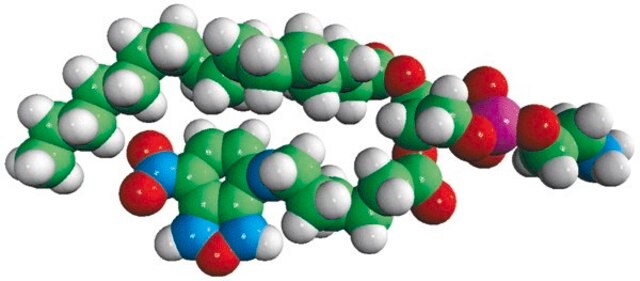840029P
Avanti
18:0 PS
Avanti Research™ - A Croda Brand
Synonym(e):
1,2-dioctadecanoyl-sn-glycero-3-phospho-L-serine (sodium salt); DSPS; PS(18:0/18:0); 110671
About This Item
Empfohlene Produkte
Beschreibung
1,2-distearoyl-sn-glycero-3-phospho-L-serine (sodium salt)
Assay
>99% (TLC)
Form
powder
Verpackung
pkg of 1 × 10 mg (840029P-10mg)
pkg of 1 × 25 mg (840029P-25mg)
pkg of 1 × 500 mg (840029P-500mg)
Hersteller/Markenname
Avanti Research™ - A Croda Brand
Lipid-Typ
cardiolipins
phospholipids
Versandbedingung
dry ice
Lagertemp.
−20°C
SMILES String
[H][C@@](COP([O-])(OC[C@](C([O-])=O)([H])[NH3+])=O)(OC(CCCCCCCCCCCCCCCCC)=O)COC(CCCCCCCCCCCCCCCCC)=O.[Na+]
InChI
1S/C42H82NO10P.Na/c1-3-5-7-9-11-13-15-17-19-21-23-25-27-29-31-33-40(44)50-35-38(36-51-54(48,49)52-37-39(43)42(46)47)53-41(45)34-32-30-28-26-24-22-20-18-16-14-12-10-8-6-4-2;/h38-39H,3-37,43H2,1-2H3,(H,46,47)(H,48,49);/q;+1/p-1/t38-,39+;/m1./s1
InChIKey
SJRBMGBLPUBGJL-MBAWARMDSA-M
Verwandte Kategorien
Allgemeine Beschreibung
Anwendung
Biochem./physiol. Wirkung
Verpackung
Rechtliche Hinweise
auch häufig zusammen mit diesem Produkt gekauft
Lagerklassenschlüssel
11 - Combustible Solids
WGK
WGK 3
Flammpunkt (°F)
Not applicable
Flammpunkt (°C)
Not applicable
Analysenzertifikate (COA)
Suchen Sie nach Analysenzertifikate (COA), indem Sie die Lot-/Chargennummer des Produkts eingeben. Lot- und Chargennummern sind auf dem Produktetikett hinter den Wörtern ‘Lot’ oder ‘Batch’ (Lot oder Charge) zu finden.
Besitzen Sie dieses Produkt bereits?
In der Dokumentenbibliothek finden Sie die Dokumentation zu den Produkten, die Sie kürzlich erworben haben.
Kunden haben sich ebenfalls angesehen
Unser Team von Wissenschaftlern verfügt über Erfahrung in allen Forschungsbereichen einschließlich Life Science, Materialwissenschaften, chemischer Synthese, Chromatographie, Analytik und vielen mehr..
Setzen Sie sich mit dem technischen Dienst in Verbindung.











